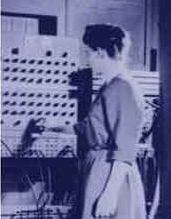The recent issue of Weekendavisen – a highly respected Danish weekly newspaper – published an article in the Oct. 23-30 issue on the early game development project that featured my current colleague Søren Lauesen and the Danish poet, inventor and game developer Piet Hein. The article is in Danish and comes in part 1, pdf 2.4 MB and part 2, pdf 0.6 MB
The article – in Danish unfortunately – is based on my recent paper “Context and Driving Forces in the Development of the Early Computer Game Nimbi” in IEEE Annals of the History of Computing. The paper can be downloaded from the post below.
Archive for the ‘Uncategorized’ Category
Nimbi in Weekendavisen
November 3, 2009Unusual UI-constraint in an early computer game
September 21, 2009My exploration of an early computer game development has been published recently in IEEE Annals of the History of Computing (download article pdf 9.3 MB). The unusual UI aspect of the game is that – unlike many contemporary computer games played on the computer terminal or console as typed characters – the designers of this game opted for a proper game board, i.e to adhere to the principle of user interface consistency (having the computer representation of the real world mirror the real world). Fine – but do note that this principle was not at all coined in 1962-63 when this development took place. What farsighted game designers!

In those early days, connecting an unusual I/O device was cumbersome: the game board became hardwired to the central register of the Gier computer. This meant that only one computer was equipped to play the game – that in turn implied that the game was never used as intended to promote computers towards the public.
Reference A H Jørgensen: Context and Driving Forces in the Development of the Early Computer Game Nimbi. IEEE Annals of the History of Computing, Vol. 31, No. 3, July-September 2009, 44-53.
ENIAC programmer Jean Bartik
May 18, 2009Do you recall the pictures of ENIAC programmers at work: moving plugs and setting switches while standing up and keeping track of the program on sheets of papers?
the pictures of ENIAC programmers at work: moving plugs and setting switches while standing up and keeping track of the program on sheets of papers?
In a recent issue of Communications of the ACM (vol. 52, no. 1, p. 17) a one-page article A Pioneer Woman by Michael Ross appeared, featuring a very interesting project ENIAC Programmers Project run by Kathy Kleiman. Abeit short, the aticle is really interesting as it brings this famous chapter of computing history to (more) life.
Regarding user interfaces, the article discloses that there were no manuals available for the for the ENIAC programmers. So the programmers, among these Jean Bartik, “pored over its logical and electrical block diagrams and discussed design details with the male engineers and physicists who had created ENIAC.”
GUI/OS resource page
May 18, 2009Several collegues have directed my attention to an interesting website
Operating System Interface Design Between 1981-2009. The website comprises a fine range of systems, and not only lists well-known systems like Xerox Star, Lisa, Mac, Amiga Workbench, and Windows, buts also less known ones like GEM, KDE, and GNOME. Regarding user interfaces, the website presents fine screenshots from all the systems. I find that the term Operating Systems is a bit misleading as the paper does not present the command line interfaces of UNIX, LINUX, etc. So I suggest you think of the site as a GUI history site.
Excellent introduction to computing history for computers scientists
May 18, 2009Thomas Haigh published an excellent introduction to computing history URL some years ago. It addresses a large number of relevant aspects of computer and computing history, including the practice of historians work (compared to that of computer scientists), relevant sources, snippets of the history of the history of computing, different kinds of history areas, etc.
As the paper appears in an edited volume on using history in the teaching of computer science, the paper also carries a section on this relevant topic.
As to user interfaces, the paper carries nothing of particular interest. But user interface history is emebedded in the history of computing, this topic is very valuable.
References
Haigh, Thomas (2004): The History of Computing: An Introduction for the Computer scientist. In: Aspray, W. and Atsushi, A. (2004): (eds): Using History to teach Computer Science and related disciplines. Washington DC: Computing Research Association, 5-26.
Akera, Atsushi and Aspray, William (2004) (eds): Using history to teach computer science and related disciplines. Computing Research Association, Washington.
The whole volume can be downloaded in Pdf (note 1.7 MB, 309 pages)
Documents from the SIG available
April 14, 2008The documents from the UI History SIG are now available for download under the page “materials”:
– the powerpoints
– the minutes by Brad
– the list of participants
– the list of literature cited in the introduction
Contact
April 9, 2008In case you want to contact me, send me an email or leave a comment on the blog.
Welcome
April 9, 2008Welcome to this blog on UI & HCI History. The blog was created in conection with a Special Interest Group on User Interface History at CHI 2008 in Florence on April 10, 2008, co-organized with Brad Myers from Carnegie-Mellon University.
The Special Interest Group aims at
– investigating the possibilities of launching a concerted effort towards creating a History of User Interfaces
– gauging the interest, motivation and commitment towards UI/HCI History in the CHI community
If you are unfamiliar with this area
– UI is short for User Interfaces to computers and other types of computerized gear
– HCI is short for the academic field Human-Computer Interaction that addresses theoretical, methodological and practical aspects of understanding and developing technology for people